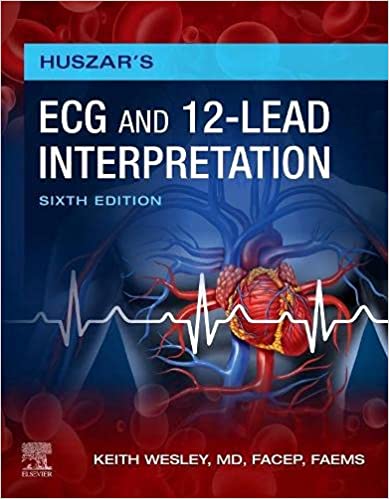목차
1. Anatomy and physiology of the heart
Cardiac anatomy and physiology
Electrical conduction system of the heart
Cardiac cells
Electrophysiology of the heart
Autonomic nervous system control of the heart
Take-home points
Chapter review questions
2. ECG leads and cardiac monitoring
Basic ECG concepts
Basic components of a normal ECG
ECG leads
Acquiring a quality ECG
Take-home points
Chapter review questions
3. Components of the ECG waveform
Waves
P wave
QRS complex
T wave
U wave
Intervals
PR interval
QT interval
R-R interval
Segments
TP segment
PR segment
ST segment
Take-home points
Chapter review questions
4. Step-by-step ECG interpretation
Systematic approach to ECG analysis
Step One: Determine the rate
Step Two: Determine regularity
Step Three: Identify and analyze the P, P′, F, or f waves
Step Four: Determine the PR or RP′ interval and atrioventricular conduction ratio
Step Five: Identify and analyze the QRS complexes
Step Six: Determine the origin of the rhythm
Step Seven: Identify the rhythm
Step Eight: Assess clinical significance
Take-home points
Chapter review questions
5. Sinus rhythms
Normal sinus rhythm
Sinus arrhythmia
Sinus bradycardia
Sinus arrest and sinoatrial exit block
Sinus tachycardia
Take-home points
Chapter review questions
6. Atrial rhythms
Premature atrial complexes
Wandering atrial pacemaker
Atrial tachycardia and multifocal atrial tachycardia
Atrial flutter
Atrial fibrillation
Take-home points
Chapter review questions
7. Junctional rhythms
Premature junctional complex
Junctional escape rhythm
Nonparoxysmal junctional tachycardia (accelerated junctional rhythm, junctional tachycardia)
Paroxysmal supraventricular tachycardia
Take-home points
Chapter review questions
8. Ventricular rhythms
Premature ventricular complex
Ventricular tachycardia
Ventricular fibrillation
Ventricular escape rhythm (idioventricular rhythm)
Asystole
Take-home points
Chapter review questions
9. Atrioventricular blocks
First-degree AV block
Second-degree type I AV block (wenckebach)
Second-degree type II AV block
Second-degree 2:1 and advanced AV block
Third-degree AV block
Take-home points
Chapter review questions
10. Implanted pacemaker rhythms
Pacemakers
Types of pacemakers
Pacemaker rhythm
Pacemaker malfunction
Implantable cardioverter-defibrillator therapy
Take-home points
Chapter review questions
11. Treatment of rhythm disturbances
Assessing the patient
Treating the patient
Bradycardia (Fig. 11.1)
Tachycardia
Premature ectopic beats
Take-home points
Chapter review questions
12. The 12-lead ECG: Leads and axis
Leads
Electrical impulse
Electrical axis and vectors
Hexaxial reference figure
Take-home points
Chapter review questions
13. Bundle-branch and fascicular blocks
Anatomy and physiology of the bundle-branch conduction system
Right bundle-branch block
Left bundle-branch block
Hemiblock
Left anterior fascicular block (left anterior hemiblock)
Left posterior fascicular block (left posterior hemiblock)
Bifascicular block
Nonspecific intraventricular conduction delay
Differentiating between supraventricular tachycardia and ventricular tachycardia
Take-home points
Chapter review questions
14. Hypertrophy, electrolytes, and other ECG findings
Heart chamber enlargement
Distention
Hypertrophy
Right atrial enlargement
Left atrial enlargement
Right ventricular hypertrophy
Left ventricular hypertrophy
Pericarditis
Electrolyte imbalance
Hyperkalemia
Hypokalemia
Hypercalcemia
Hypocalcemia
Other ECG findings
Drug effects
Pulmonary embolism
Chronic cor pulmonale
Early repolarization
Hypothermia
Accessory conduction pathways and preexcitation syndromes
Supraventricular versus ventricular tachycardia
Brugada syndrome
Take-home points
Chapter review questions
15. Coronary heart disease and the 12-lead ECG
Coronary circulation
Coronary heart disease
Thrombus formation and lysis
Myocardial ischemia, injury, and infarction
Pathophysiology of myocardial infarction
Take-home points
Chapter review questions
16. ECG diagnosis of myocardial infarction
Septal myocardial infarction
Anterior myocardial infarction
Anteroseptal myocardial infarction
Lateral myocardial infarction
Anterolateral myocardial infarction
Extensive anterior myocardial infarction
Inferior myocardial infarction
Posterior myocardial infarction
Right ventricular myocardial infarction
Diagnosing MI in the presence of bundle-branch block
Diagnosing MI in the presence of left ventricular hypertrophy
Distinguishing pericarditis from myocardial infarction
Take-home points
Chapter review questions
17. Diagnosis and treatment of acute coronary syndrome
Presentation of myocardial infarction
History taking in suspected acute coronary syndrome
Signs and symptoms of acute coronary syndrome
Management of acute coronary syndrome
Goals of management
Management of specific conditions
Take-home points
Chapter review questions
Appendix A: Answers to chapter review questions
Appendix B: Rhythm interpretation Self assessment
Appendix C: Self assessment answer key
Glossary
Index
상품상세정보
Learn to interpret cardiac dysrhythmias and successfully treat patients! Huszar's ECG and 12-Lead
Interpretation, 6th Edition uses a step-by-step approach to help you build skills in accurate rhythm
interpretation, diagnosis, and clinical management. Correlating ECG interpretation with clinical signs and
symptoms, the text begins with basic skills and progresses to more advanced concepts. Hundreds of ECG
rhythm strips provide plenty of practice with identifying heart rhythms. Written by experienced EMS
physician and educator Keith Wesley, this guide is also ideal for quick reference while on the job,
anywhere from the emergency department to the back of an ambulance.
•Comprehensive review of heart rhythm interpretation reflects current ECC guidelines.
•Logical organization of material teaches the way in which readers learn specific skills ― ECG components
are presented first, followed by rhythm interpretation and then clinical applications.
•Coverage of both basic and advanced concepts incorporates the latest research developments and provides
material pertinent to both beginners and experienced prehospital care providers.
•Recognition of various heart rhythms is promoted by their appearance on the ECG, correlated with the
patient’s clinical signs and symptoms.
•Patient care algorithms outline step-by-step management and treatment, correlating ECG interpretation with
history and exam findings.
•Advanced-level treatment content includes complete thrombus formation, treatment, and management.
•Take-Home Points summarize each chapter, highlighting need-to-know information about the most important
topics.
•Author’s Notes provide tips on alternative diagnoses, possible complications of warning signs, normal
variations, and more, allowing you to benefit from the author’s decades of experience.
•Expert author Dr. Keith Wesley is a board-certified emergency medicine physician and has been involved in
EMS since 1989.
•Learning features include chapter outlines, learning objectives, key terms, chapter review questions,
quick-reference summaries of the key characteristics of each heart rhythm, Drug Caution boxes, and a
glossary.
•NEW! Updated content includes the latest guidelines from the American Heart Association Guidelines for
Cardiopulmonary Resuscitation and Emergency Cardiovascular Care and also the International Consensus on
Cardiopulmonary Resuscitation and Emergency Cardiovascular Care Science with Treatment Recommendations.
•NEW! Updated learning features include key definitions, ECG Keys boxes, Take-Home Points, author’s notes,
chapter review questions, an appendix of more than 250 self-assessment rhythm strips, and an appendix of
answers to the chapter review questions.


